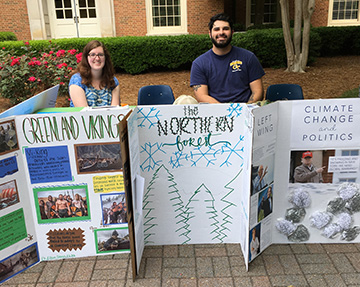
Samford University continues to uphold a key part of the vision statement to be “aggressive in self-assessment and continuous improvement.” New programs and initiatives are in place across the campus to help the community emphasize a mind-set and lifestyle that promotes an equitable and sustainable future for all humankind in harmony with nature.
One way Samford upheld its commitment to sustainability is through the celebration of Earth Day April 20. Students and employees along with businesses from the Birmingham community came together to celebrate achievements and plan for the future.
Booths lined Ben Brown Plaza, and included departments and groups such as S.A.V.E. (Sustaining a Village Everyday), Samford Sustainability featuring Johnson Controls, Samford’s Christenberry Planetarium, a Samford Scientific Methods class and CommuteSmart.
Senior human development and family science major Cara Jean Griggs spent the morning serving at the S.A.V.E. booth.
“S.A.V.E. is a student-led nonprofit,” said Griggs. “Every spring break, we do medical clinics in Boukeron, Haiti, and throughout the year, we do concerts to raise money for the medical needs and to make S.A.V.E more known. We try to be all about sustainability in Haiti; that’s our main focus.”
Samford’s partnership with Johnson Controls Inc., is part a new campus infrastructure improvement program. Mark Fuller, Samford’s director of facilities, is pleased with the progress being made with the initiatives.
“You can see a number of things happening around campus, from windows being replaced, to new water fixtures, to new chilling plants that just opened and [started] running last week,” Fuller said. “We will cut the use of utilities dramatically. Twenty million gallons a year in savings are due to the fixture replacements, low-flow shower heads and lights. We’re doing a good part for the community as well as helping to bring about more awareness for sustainability on campus.”
Christenberry Planetarium allowed students to experience life outside earth.
“We’re celebrating the exploration of the earth and the means to go further [by] showing off the interior of the International Space Station,” said David Weigel, planetarium director. “You get to explore the inside of the ISS basically using your hands and looking in any direction you want. It immerses you into a micrographic experience while your feet are still on the ground here. It’s pretty unique.”
Students from Professor Miriam Newman’s Scientific Methods class displayed the findings from a recent project called “Party at the Poles: Saving Winter.”
“It was an environmental project to focus on winter, the environment and climate change,” Newman said. “I’m so excited that Samford University is upgrading to more efficient lighting, more efficient water and doing the things that need to be done to mitigate climate change. As my students have found from all their projects, little things that we do affect the world and affect whether or not we have a good winter.”
For students wanting to earn some cash by helping reduce air pollution, Birmingham-based CommuteSmart is a great option.
“We will pay college students an incentive if they walk, ride the bus, ride their bike [or] carpool to school,” said Brenda Peterson, CommuteSmart representative. “We pay $1 a day up to $70 the first 90 days, and after that, we pay a $25 gift card every 90 days.”
Peterson is hopeful that students in the Samford community and in other area schools will take advantage of the opportunity by visiting CommuteSmart’s website. “It’s a really great program [and] it’s absolutely free. You just have to do your part.”
Olivia Williams is a journalism and mass communication major and news and feature writer in the Division of Marketing and Communication.
